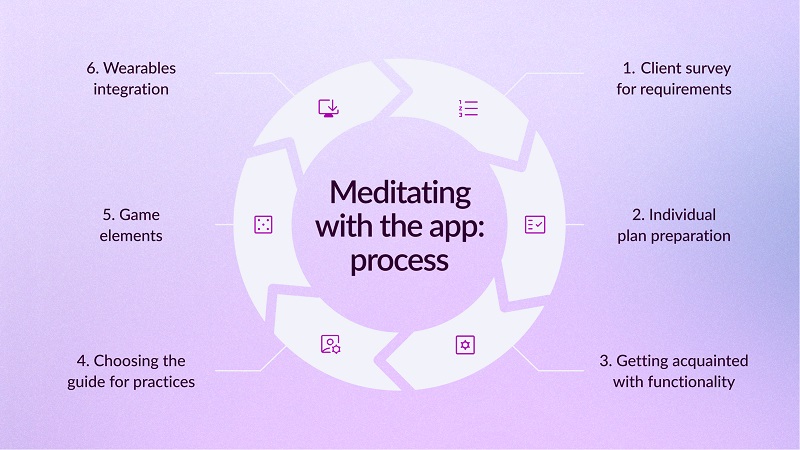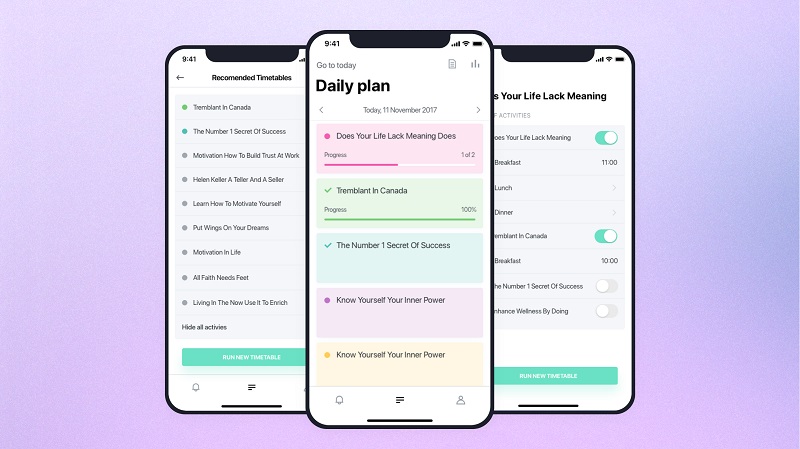Create Your Own Meditation App: Guide on Software for Inner Peace

The lifestyle of a modern person should be fast, productive, and merciless to fatigue. Holding out for a long time in such a rhythm is challenging, and living for years is dangerous. We all need a break, but taking a day off every 2 months is an unforgivable luxury. In this case, a good alternative is the practice of meditation. But we do not recommend spiritual masters, we are talking about mobile applications that will relax you after work and keep your body in good shape. Today we will discuss the benefits, effects, and meditation app development process!
Benefits of Developing a Meditation App
Why is the meditation app so popular? The answer is simple – no one wants to go to the other side of the city after a hard day’s work to meditate there and then go back. But, of course, only some people are ready to spend so much time. So mobile applications come to the rescue, allowing individuals to do meditation (or other exercises) without leaving their home.
If you have never considered creating such applications, now is the time. At the beginning of 2022, the number of downloaded meditation apps increased by 25%. But what are the benefits of developing such applications? Let’s list them briefly:
- Wide audience. Every year there are more and more reasons for concern, people need an outlet, some alternative, and your application can become it.
- Lots of monetization options. The format of the application, which offers the services of a kind of “mentor,” allows you to integrate both advertising ads and paid courses, tips, etc. (we’ll look at it in more detail later).
- Easy accessibility of the application. Naturally, this also increases the coverage of the target audience because, for meditation, you do not need to buy simulators or rent a room. You just need to launch the app.
Considering the above, meditation apps can be a profitable investment. But before talking about the technical aspects, we should discuss the primary specifics of the application – how to attract a client and motivate them to meditate.
How to Meditate Using Mobile Apps?
Meditation is a highly personal process but can be put on a mobile footing. So let’s take a step-by-step look at how to attract users (and how to monetize them).
Onboarding
The first launch of the application for the user is decisive. They will simply turn away from you if they don’t like something. Therefore, consider the interface and functionality in detail to attract a potential client. A person who launches applications for the first time should not have questions like: “What should I do?” and “Where to click?”. Often, the user is provided with a free trial to get acquainted with the full functionality.
Evaluation of mental health status
The client turns to your application’s services, most likely not because of simple interest but because of fatigue, nervousness, or other hardships. Try to think of functionality in a way that helps the user deal with problems. If everything works out for you, the potential client will likely stay.
Prescribed guide
The vast majority of users have never practiced meditation, so you need to explain to them the possible exercises and what they should feel as a result. Detailed instructions in such applications are a must-have. Pay attention to them.
Individual approach
All people are different; all have their own needs and specifics. Therefore, your application must adapt to the user. You need to segment the exercises as much as possible to do this. This will enable flexible settings for each person to adjust the rhythm, potential complexity (relevant for fitness applications), and when the user should perform exercises.
Gamification
To continue using the application, the user needs to be motivated. To do this, it is enough to develop a system of rewards. These can be conditional achievements in the profile or tips of a different level. For example, a week of free premium access. In other words, reward users more often. We all love rewards.
But from the specific plan, let’s move on to the technical side of the issue!
The functionality of a Meditation App
Application functionality can be divided into two types: basic and advanced. Let’s start with the first one.
Basic features
This section includes all elements of the “body” of the application. It is simply impossible to make a workable application by ignoring them. Basic functionality include the following:
- Sign-up form. Making use of an application requires registration.
- Personal profile. The user must be able to set conditional photos, monitor the effectiveness of exercises (conditionally), view achievements, etc.
- The archive of materials is necessary for meditation apps; this way, the user can view exercises, literature, and other information for their procedures.
- Play/stop buttons. Users should be able to pause the exercise because anything can happen – this is necessary so they do not lose progress.
- Progress tracking. Users are always interested in the result, to visually demonstrate it, indicators are needed that show the development and improvement in the state of customers.
- Push notifications. Messages on the screen will help users remember the meditation session.
- Payment gateway integration. Integrating this feature will facilitate in-app transactions (paying for a premium account or purchasing unique courses).
Advanced features
Advanced functionality is optional, but we recommend paying attention to it. It makes life easier for users and becomes the same hook – because of this, they remain in the system.
- Different voices. The choice of agent may seem like a small and generally insignificant element, but users often pay attention to them, and it would be nice to have the ability to choose voice acting.
- Motion UI. Users always like the animated and flexible interface, with it, your application will become more exciting and fun.
- Smart home integration. The feature is difficult to implement, but thanks to it, the user will get an unforgettable experience – an automatic selection of lighting, background sounds, and the ability to start meditation without using a mobile phone. This is a great feature.

From the description of the functionality, let’s move on to its implementation!
Meditation App Creation Flow
The development of a mobile application is divided into several stages, and we will consider each of them separately.
Thinking through an idea
Everything starts with an idea. You need to work out tasks of your application, its specifics, potential, audience, etc. Consider this area’s versatility if you are just thinking about developing a meditation application. So this industry cluster can be divided into:
- Relaxation
- Meditation
- Working on panic attacks
- Muscle relaxation
Contacting a professional ITT vendor
We recommend starting development with an experienced development team. Thanks to them, you can avoid mistakes both in the technical field and in marketing. This will be more expensive, but it is more likely that the application will pay off.
Market research
Studying the potential target audience is essential to consider the necessary functionality at this stage. Although it is advisable to start doing this straight off, combining the study with the search for an experienced vendor is possible.
UI/UX Design
Application design development will take a lot of time. Therefore, we don’t recommend saving at this stage since the visual design is the first thing the user pays attention to.
Development
The app development and implementation stages will take most of the time. This is the final stage, where the team integrates 3rd services and brings all the elements to a satisfactory state. The work will require scrupulousness and attention to detail, but everything would be fine if all the previous steps have been performed correctly.
Release
The application release stage should be accompanied by an enhanced advertising campaign. Be ready for the “influx of users” – do not let the servers crash or other technical problems. If they appear, then try to fix them as soon as possible.
Support
After launching the application, you need to constantly monitor the indicators of the inflow of the audience. In addition, remember to regularly update the service, add new features and fix possible errors. If you quickly respond to the audience’s needs, then the state of the application and earnings will be fine.
You are probably wondering, “How much does development cost?”. So let’s talk about it.
Cost to Build a Meditation App
The cost of developing meditation apps directly depends on their functionality. If you want to build an innovative application that can use all the technologies a user can find, then its creation will not be cheap. Also, remember that you will need the help of professionals in meditation and other wellness procedures. Therefore, we will not indicate the price for the consultation of these specialists.
But how much the development will cost approximately. Prices in the US range from $75,000 to $250,000. They depend on the factors described above in many ways, but the developer company’s geolocation also impacts the price.
Programming outsourcing will allow you to make the price lower. Developers worldwide provide services at prices often lower than in the US or Western Europe. For example, the average pricing policy for developing meditation and other physical exercise applications ranges from $25,000 to $50,000. But this is an average figure from domain statistics, keep in mind that in each case, the cost is calculated based on many factors.
Always contact experienced IT providers. Their services are always more expensive than the average on the market, but the quality will satisfy you!
Author’s bio:
Yuliya Melnik is a technical writer at Cleveroad. It is a web and mobile app development company in Ukraine. She is passionate about innovative technologies that make the world a better place and loves creating content that evokes vivid emotions.